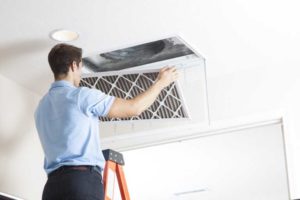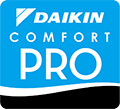Air Filters 101: Making the Best Choices for Your Texas Home
Clean filters assure proper efficiency and longevity of your AC and heating system.

Indoor comfort is all about distributing cooled or heated air throughout the house in the most energy efficient and effective way. Indoor air quality is about making sure that air is as clean and healthy to breathe as possible. As it turns out, accomplishing both can be a challenge. The components of indoor air include everything from everyday housekeeping issues like common dust or even toxic microorganisms. There’s something in the air to annoy or irritate almost anyone.
You can use our online store to take care of your filtration needs by CLICKING HERE. Filters will be conveniently delivered to your door.
There are two types of particles floating in our home’s air – Inorganic and biological.
Inorganic dust is made up of:
- Dirt particles
- Soot and ash
- Paint particles
- Chemical particulates
Biological air contaminants includes:
- Pollen
- Epidermal skin cells shed by humans
- Mold and bacterial spores
- Algae
- Insect parts—mostly dead dust mites
- Floating fibers generically described as lint may be carpeting and clothes fibers, hair from humans and pets, bits of spun fiberglass insulation, plant fibers and even spider webs and cobwebs.
No wonder, then, that the Environmental Protection Agency (EPA) has found the indoor environment in homes to be typically as much as two to five times more polluted than outdoor air. In part, we’ve created the situation ourselves as we’ve made today’s homes more energy efficient than ever by airtight construction methods. The lack of air exchange with the outdoors permits indoor toxins to accumulate and concentrate to levels previously unknown.
Filter Efficiently, Change Often
The blower in the typical residential HVAC system circulates an average of 1,400 cubic feet of air per minute. That’s a lot of air in continuous motion and a load of airborne particulates moving along with it. The front line for removing these particles from your breathing air i the filter that is part of your HVAC system. There are two basic types of filters – the simple one-inch thick filters located behind the grid on your ceiling or wall air returns, or the media filter, that is located on your furnace or air handler in you attic that are from four to six inches thick
The system’s air filter screens all air moving through your return ductwork as it is pulled back to the furnace or air handler from every room in the house by the power of the blower located in the furnace or air handler. As long as the system is running, air is being filtered and the filter is slowly accumulating trapped particulates.
Manufacturer’s recommendations may call for filter changes at intervals up to every three months for media filters and monthly for the one-inch filters. Most HVAC experts, however, advocate changes more often during the height of the heating and cooling season. Filters are typically less expensive when purchased from our on-line service (click here for filter store), and the filter change procedure is a simple DIY task anyone can do. So, regular changes make sense from an air quality, energy efficiency and economic standpoint. The more efficient filter a filter, the more often a filter should be changed. The way to determine which filter is right for your home, is to look at the MERV rating of the filter.
Which Filter?
All filters are not created equal and that’s a good thing. Not every filter is right for every HVAC system or indoor air environment. Occupants of homes differ, too, in their air quality needs. Households that include individuals sensitive to airborne particulates or susceptible to respiratory infections will obviously require a higher standard of filtration. But how do you know what level of filtration you can expect from a particular make or model? Just ask MERV.
MERV is short for Minimum Efficiency Reporting Value, a system that designates the efficiency of air filters by assigning a numerical rating between 1 and 16, ranging from the least to the most efficient filtration. Most manufacturers prominently display a filter’s MERV rating on the packaging so you can compare different efficiencies at a glance. MERV ratings are determined by laboratory tests devised by the American Society of Heating, Refrigeration and Air Conditioning Engineers (ASHRAE).
MERV 1 to 4
These filters are generally the original equipment filters typically included with the system when you buy it. Among HVAC technicians, they are often regarded as “throwaway” filters. However, many homeowners will simply choose to replace these original filters with the same type for the life of the system. In most cases, that’s a bad choice.
These flat panel filters with a filter media that is usually composed of spun fiberglass represent the bottom of the filtration efficiency ladder. Filters in this MERV range are designed to simply remove the largest particulates in the air—basically the stuff you can actually see floating around—in a size range of 10 microns or larger. They are most useful for the purpose of protecting moving parts in the system from wear and tear, not for optimum indoor air quality.
MERV 5 to 8
While still in the disposable class of filters, these models utilize cotton or polyester pleated filter media. By pleating the media, the available filtration surface area is greatly increased. Homeowners who upgrade to filters in this range can expect efficiency that removes over 90 percent of airborne particulates with a size range of 3 to 10 microns. This includes all forms of dust and lint, pollen, mold spores, pet dander, hair spray and other aerosols.
MERV 9 to 12
For superior indoor air quality, these pleated filters protect by removing 95 percent of particulates down to a size of 1 micron. Filters in this range will begin to obstruct system airflow if they are left in place when they are dirty. Therefore, homeowners who choose this superior level of protection must also assume greater vigilance and more frequent cleaning or replacement to sustain proper airflow.
MERV 13 to 16
While these filters offer the gold standard in air filtration—including capturing particles as small as viruses and smoke—they are generally not appropriate for one-inch filters due to excessive airflow restriction. Only applications with media filters that can handle much higher system airflow can utilize a standard installation of MERV 13 to 16 filtration, and sometimes modifications to the airflow need to made to accommodate such high filtering.
Clean filters assure proper efficiency and longevity of your AC and heating system. For informed answers about the MERV system of filter efficiency and how to achieve optimum indoor air quality without restricting proper air flow for your system, contact the professionals at Air National Texas at 281-251-3143.


